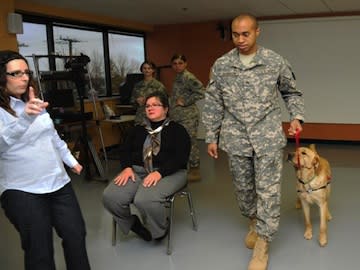 The Sideshow
The SideshowMilitary dogs taking Xanax, receiving therapy, for canine PTSD

Even the most hardened soldier can escape grievous wounds on the battlefield only to suffer deeply painful psychological traumas after returning home. And unfortunately, the same pattern of psychic trauma seems to apply for the dogs that help provide essential services for military men and women.
New York Times reporter James Dao has a heartbreaking story today, which reports that among the present corps of 650 military dogs, more than 5 percent deployed with American combat forces are suffering from canine Post-traumatic Stress Disorder (PTSD). And of that group, about half are forced into retirement from service.
The relationship between military dogs and the service members who own them is a complex one. In fact, as recently as March, the military was highlighting the use of dogs to help treat human soldiers suffering from PTSD.
The study of canine PTSD is only about 18 months old, Dao reports, even though animal behavior has been studied for centuries:
Like humans with the analogous disorder, different dogs show different symptoms. Some become hyper-vigilant. Others avoid buildings or work areas that they had previously been comfortable in. Some undergo sharp changes in temperament, becoming unusually aggressive with their handlers, or clingy and timid. Most crucially, many stop doing the tasks they were trained to perform.
"If the dog is trained to find improvised explosives and it looks like it's working, but isn't, it's not just the dog that's at risk," said Dr. Walter F. Burghardt Jr., chief of behavioral medicine at the Daniel E. Holland Military Working Dog Hospital at Lackland Air Force Base "This is a human health issue as well."
Military dogs have reportedly become the most effective tool for detecting improvised explosive devices (IED's) in the battlefield. IED's are typically composed of chemicals, rather than metals--which makes them especially hard to detect via conventional electronic monitoring systems.
And as Dao goes on to explain, testing the dogs for PTSD is a complex process:
In a series of videos that Dr. Burghardt uses to train veterinarians to spot canine PTSD, one shepherd barks wildly at the sound of gunfire that it had once tolerated in silence. Another can be seen confidently inspecting the interior of cars but then refusing to go inside a bus or a building. Another sits listlessly on a barrier wall, then after finally responding to its handler's summons, runs away from a group of Afghan soldiers.
Once a military dog is diagnosed with PTSD, Dr. Burghardt works directly with veterinarians on treatment:
Since the patient cannot explain what is wrong, veterinarians and handlers must make educated guesses about the traumatizing events. Care can be as simple as taking a dog off patrol and giving it lots of exercise, play time and gentle obedience training.
More serious cases will receive what Dr. Burghardt calls "desensitization counter-conditioning," which entails exposing the dog at a safe distance to a sight or sound that might trigger a reaction—a gunshot, a loud bang or a vehicle, for instance. If the dog does not react, it is rewarded, and the trigger—"the spider in a glass box," Dr. Burghardt calls it—is moved progressively closer until the dog is comfortable with it.
Some dogs are even treated with the anti-anxiety drug Xanax. That regimen permits them not merely to recover from their trauma, experts say--it also helps them eventually return to active duty. Those dogs unable to re-enlist are allowed to retire, either with an adoptive family or an inactive service member.
Other popular Yahoo! News stories:
• Flying squirrels invade hospital emergency room for second time in two weeks

